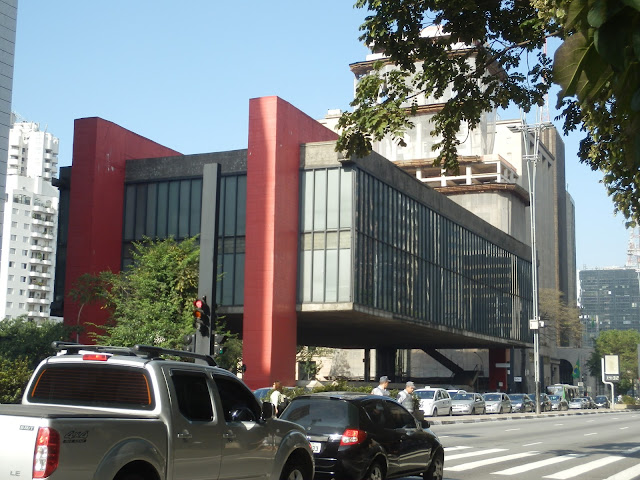One good thing about being in a foreign country is you'll get to know about different cultures and history from that country.
Apart from the Rio+20 and World Youth Congress report, I would like to share a bit of my journey in Rio and Sao Paulo. This time, I'll take you to Sao Paulo and have a look for its enriched history, architectures, people, art and culture.
The
São Paulo City
São Paulo is the largest city in Brazil, the largest city in the southern hemisphere and Americas, with more than 10.6 million people residing in the city and it's the world's seventh largest city by population.
São Paulo is also one of the ten largest metropolitan areas on the planet with its strong regional influence in commerce and finance as well as arts and entertainment. The metropolis has significant cultural, economic and political influence both nationally and internationally. Today we will go through briefly several magnificent sites that show the depth of this big city.
Skyscrapers
The first impression about the São Paulo city is its skyscrapers. Since I'm staying in a high-rise condominium, I could view the city with its magnificent view - skyscrapers in East, West, South, North, it's everywhere! No hills or forest as seen in Rio de Janeiro, this city is really, really big!
 |
| Sao Paulo City stretched to the far far end. |
Museu do Ipiranga
This huge neo-renaissance-style palace, whose Baroque gardens take after Versailles, opened in 1890 on the site where Dom Pedro I declared Brazil independent of Portugal. The huge, 125,000-piece collection ranges from 16th to the mid-20th century. It includes sculptures, paintings, documents and weapons, and so on. The great hall features the famous painting Independencia on morte, by Pedro Americo. In front of the museum is a beautiful Baroque-style garden, with fountains where people jog, walk their pets, play skate boards and sunbathing in there. Further in front of that garden, is the monument to Independence in the Independence park. Daniel the marvelous traveller said there was once a very, very huge Brazilian flag located in the center of the park, but somebody, with some capability, stolen the flag. We have no idea how could he/she/they do that.
 |
| Museu do Ipiranga, a huge neo-renaissance-style palace. |
Museu de Arte de Sao Paulo
MASP, as it's called, contains the most valuable collection of paintings in Latin America. The current building was designed by Lina Bo Bardi and constructed in 1968 with concrete and glass. The box-like structure is supported by four pillars, creating a 74 meters span. The 5500-piece collection includes paintings by Van Gogh, Cezanne, Monet, Manet, Renoir, Valezquez, Goya, Rembrandt, as well as collection by Edgar Degas. It is also considered a landmark of the city which is located at the famous Paulista Avenue (like Bukit Bintang in Kuala Lumpur). The art museum, institutes and library in MASP played important roles in shaping and conserving the Brazilian art!
Estadio do Pacaembu
This stadium is also known as Municipal Stadium of Sao Paulo. They have a football museum in the lower ground floor beneath the stadium where football fans can find historical photographs along with visits to the playing field, sport center, the great hall, the radio and TV broadcasting booths. It's a place for Sao Paulo football club fans to go on weekend on any matches of their favourite clubs. Basically, most of the Brazilian have their own cup of tea, since there are soooo many sport clubs in Brazil. So, Daniel the marvelous traveller said he preferred Corinthians Paulista which based in Sao Paulo, second most famous team in Brazil and have 24-26 million fans. The winning club in national championship could represent in the national team in international sport events like World Cup!
 |
| This is the stadium! Pacaembu! |
Edificio Italia
The 42-story Edificio Italia is one of the tallest buildings in Sao Paulo, at 165 meters. It is designed by the famous architect Adolf Franz Heep, and has the highest observation point in the city. Like KL Tower, it has Terraco Italia restaurant on the top two floors where we can view the Edificio Copan and sunset. However, there are charges to enter the restaurant and so we just take some photos from the 33rd floor.
Edificio Copan
Designed by Oscar Niemeyer, the building opened in 1966, fifteen years after the plan was first drawn. It's the greatest example of modernist architecture in Sao Paulo. Its signature features are the serpentine structure and the horizontal lines. The Copan is one of the largest reinforced concrete structures in the country.
Edificio Copan
Designed by Oscar Niemeyer, the building opened in 1966, fifteen years after the plan was first drawn. It's the greatest example of modernist architecture in Sao Paulo. Its signature features are the serpentine structure and the horizontal lines. The Copan is one of the largest reinforced concrete structures in the country.
Teatro Municipal
 |
| Youth dress in punk gathered in front of the theater for some activity. |
To be continued. =)



No comments:
Post a Comment
Write your thoughts about my blog for improvement! Thank you!